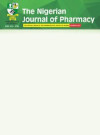Hepatoprotective Activity Of Ethanolic Stem Extract Of Homalium Letestui Against Thioacetamide-Induced Liver Injury
Keywords:
Homalium letestui, hepatoprotective, thioacetamideAbstract
There is an immensely growing demand for research into plants that is of benefit in protecting and/or healing vital organs in the body. Homalium letestui plant is a plant of folkloric importance that is used in management of several ailments. The hepatic protective ability of ethanolicextract of the plantagainst thioacetamide induced liver injury in rats was investigated. Thirty six (36) male adult abino rats were divided into 6 groups of six rats per group. Group 1 received normal saline 10 mg/kg, group 2 received thioacetamide 200 mg/kg and group 3 were administ3.ered Silymarin 100 mg/kg. Animals in group 4, 5 and
6 received 250, 500 and 750 mg/kg respectively of ethanol stem extract of Homalium letestui plant. Administration was carried out for 8 days after which animals were sacrificed. Examination of liver function parameters and histopathological observations were used to assess hepatoprotective activity of the stem extract. There was significant (p≤ 0.05) decrease in level of liver enzymesAST, ALT and ALP, increase in endogenous level of total cholesterol, total and direct bilirubin and decreases in total protein and albumin levels when compared to control. Histopathological examination agrees with that of chempathology results suggesting the plant may have organ protective ability. The extracts result was also comparable to
that of standard drug used. The result of the study shows that the plant may possess hepatoprotective activity which supports it use in traditional medicine as an antidote.
References
Halliwell, B. (1996). Antioxidants in Human Health and Disease. Annual Review of Nutrition. 16:33–50.
Rice-Evans, C.A., Miller, N.J. and Paganga, G. (1996). Structure Antioxidant Activity Relationships of Flavonoids and Phenolic Acids. Free Radical Biology and Medicine, 20, 933–56.
Halliwell, B. and Gutteridge, J. M. (1984) Oxygen Toxicity, Oxygen Radicals, Transition Metals and Disease. Biochemical Journal, 219, 1–14.
Prior, R. L. and Cao, G. (1999). Variability in Dietary Antioxidant Related Natural Product Supplements: The Need for Methods of Standardization. Journal of American Nutraceutical Association, 2, 46–56.
Dhawan, B. N., Koslow, S. H., Murthy, R. S. and Coelho GV., (2005). Decade of the Brain: India/USA Research in Mental Health and Neurosciences Rockville: National Institute of Mental Health, 197-202
Dieter Häussinger, ed. (2011). Liver Regeneration. Berlin: De Gruyter. p. 1 – 350.
Shneider, B. L. and Sherman, P. M. (2008). Pediatric Gastrointestinal Disease. Connecticut: PMPH-USA. p. 751.
Eliwa, H. A., El-Denshary, E. S., Nada, S. A., Elyamany, M. F., Omara, E. A. and Asaaf, N. (2014). Evaluation of the Therapeutic Effect of Whey
proteins on the Hepatotoxicity Induced by Paracetamol and Alcohol Co-administration in Rats. International Journal of Progressive Pharmaceutical Research, 3, 295-314.
Aubréville, A. (1959) De quelques Césalpiniées africaines. Bulletin de la Société Botanique de France, 104, 495–498.
Bouquet, A. and Debray, M. (1974). Medicinal Plant of the Ivory Coast. Trav Doc Orstom, 32. Pp 441.
Okokon, J.E., Ita, B. and Udokpoh, A.E. (2006). Antiplasmodial Activity of Homalium letestui. Phytotherapy Research, 20, 949–951.
Okokon, J. E , Okokon, P. J , Dar Farooq, A . and Choudhary, M. I . (2013). Anti-inflammatory and Antinociceptive Activities of Homalium letestui. Pharmaceutical Biology. 1459-66.
Okokon, J.E., Antia, B.S. and Ita, B.N. (2007). Antidiabetic Effects of Homalium letestui (Flacourtiaceae) in Streptozotocin Induced Diabetic Rats. Research Journal of Medicinal Plants, 1, 134–138.
Okokon, J. E. and Davies, K. (2014). Psychopharmacological Studies of Mammea africana Stem Bark Extract. The Journal of Phytopharmacology, 3, 204–213.
Ita, B. and Ngochindo, R. (2014). Fatty Acid Composition, Antioxidant and Antimicrobial Activity of Homalium letestui Stem. Australian Journal of Basic and Applied Sciences, 8, 416-422.
Reitman, S. and Frankel, S. (1957). Glutamic – Pyruvate Transaminase Assay by Colorimetric Method. American Journal of Clinical Pathology, 28, 56.
. Mülle r, A . , Machnik , F. , Zimmermann, T. and Schubert, H. (1988). Thioacetamide-induced cirrhosis-like liver lesions in rats—usefulness and reliability of this animal model. Experimental Pathology, 34,229–236.
Brandon, E., Schrum, L. W, Schmidt, C. M. and McKillop, I. H. (2012). Rodent Models of Alcoholic Liver Disease of Mice and Men. Alcohol, 46, 715-25.
Low, T.Y., Leow, C.K., Salto-Tellez, M. and Chung, M.C.(2004): A Proteomic Analysis of Thioacetamide - Induced Hepatotoxicity and Cirrhosis in Rat Rivers. Proteomics, 4, 3960-3974.
Muddasir, S., Rajinder, R., Pawan, A. S., Kumar, V. H., Verma, W.A and Payen, E. S.(2013). Hepatoprotective Mechanisms of Ageratum conyzoides L. on Oxidative Damage Induced by Acetaminophen in Wistar Rats. Human Experimental Toxicology, 65, 429 – 437.
Travlos, G.S., Morris, R.W., Elwell, M.R., Duke A., Resenblum, S. and Thompson, M. B. (1996). Frequency and Relationships of Clinical
Chemistry and Liver and Kidney Histopathology Findings in 13-week Toxicity Studies in Rats. Toxicology, 107, 17–29.
Bartosz, G. (2000). Free Radicals in Biology and Medicine, Cell Biology International. 24, 764 - 770.
Shapiro, H., Ashkenazi, M., Weizman, N., Shahmurov, M., Aeed H. and Bruck R. (2006). Curcumin Ameliorates Acute Thioacetamide-Induced
Hepatotoxicity, Journal of Gastroenterology and Hepatology. 21 (2). Pp. 521.
Doi, K., Kurabe, S., Shimazu, N. and Inagaki, M. (1991). Systemic Histopathology of Rats with CCl4-Induced Hepatic Cirrhosis, Laboratory Animals, 25, 21-25.
Sicherer, S. and Sampson, H. A. (2010). Allergen and Immunological Consequences. Journal of Allergy and Clinical Immunology. 125 (22), 116-25.
Kumar, A. (2012). A Review on Hepatoprotective Herbal Drugs. International Journal of Research in Pharmaceuticals, 2, 92-102.
Alshawsh, M. A., Abdulla, M. A., Ismail, S. and Amin, Z. A. (2011). Hepatoprotective Effects of Orthosiphon stamineus Extract on Thioacetamide-Induced Liver Cirrhosis in Rats. Evidence-Based Complement and Alternative Medicine, 6, 1-6.

Downloads
Views | PDF Downloads:
338
/ 204


